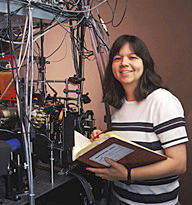Ultracold Molecules Pave Way for Quantum 'Super Molecule'
Achievement could Improve understanding of superconductivity.

Physicist Deborah Jin in her laboratory at JILA, a joint institute of the National Institute of Standards and Technology and the University of Colorado, Boulder.
A team of researchers at JILA, a joint institute of the Commerce Department's National Institute of Standards and Technology (NIST) and the University of Colorado at Boulder, has done the physics equivalent of efficiently turning yin into yang. They paired individual potassium atoms belonging to a class of particles called fermions into molecules that are part of a fundamentally different class of particles known as bosons. Though the transformation lasts only a millisecond, the implications may be long lasting.
The work, reported in tomorrow's (July 3) edition of the journal Nature, is an important step toward creating a "super molecule," a blend of thousands of molecules acting in unison that would provide physicists with an excellent tool for studying molecular quantum mechanics and superconductivity. Creation of a "super atom" (known as a Bose-Einstein condensate or BEC) earned another research team at JILA the 2001 Nobel Prize in physics.
In the Nature paper, NIST's Deborah Jin and colleagues describe their experiments to produce these exotic molecules at temperatures of only about 150 nanoKelvin above absolute zero. The technique involves manipulating a cloud of atoms within an ultra-high vacuum chamber with lasers and magnetic fields to coax the atoms to pair up into loosely joined molecules. Surprisingly, the researchers report, the number of molecules produced is very large—with about a quarter million or 50 percent of the atoms within the original cloud pairing up.
"This work," Jin notes, "could help us understand the basic physics behind superconductivity and especially high-temperature superconductivity."
Superconductivity is a property in which electrons (a fermion particle) move through a metal with no resistance. The experiments may lead to creation of fermion superfluids made from gases that would be much easier to study than solid superconductors.
"Our experiments," Jin continues, "produced the lowest molecular binding energy that has been measured spectroscopically." In other words, the atom pairs forming each molecule are hanging on to one another by their proverbial fingertips. They also are spaced very far apart by molecular standards. The researchers measured the amount of energy required to hold the molecules together by breaking the molecular bond with a relatively low-energy radio wave. Most molecular bonds require higher-energy light waves to break them apart.
The atoms, a form of potassium with one extra neutron (the isotope of potassium with a molecular weight of 40 rather than the more common 39), are classified as fermions. Fermions are the particles most people are familiar with—i.e., protons, neutrons, electrons—and they obey one basic rule. No fermion can be in exactly the same state at exactly the same time and place as another fermion. Hence, no two things made of ordinary matter can be in exactly the same place at exactly the same time.
The molecules formed from these potassium atoms, however, are bosons. Unlike fermions, bosons can be in exactly the same energy state in exactly the same time and space. Light waves or photons are the most commonly known bosons, and laser light is an example of how bosons can behave in unison. Bose-Einstein condensates (BECs) are the atomic equivalent of lasers. First produced in 1995 by JILA scientists Eric Cornell and Carl Wieman, BECs are a fourth state of matter in which a dense cloud of atoms acts like one huge super atom.
Funded by NIST and the National Science Foundation, the current work of Jin and her colleagues—Cindy A. Regal, Christopher Ticknor and John Bohn—builds on these earlier experiments.
As a non-regulatory agency of the U.S. Department of Commerce's Technology Administration, NIST develops and promotes measurement, standards and technology to enhance productivity, facilitate trade and improve the quality of life.

